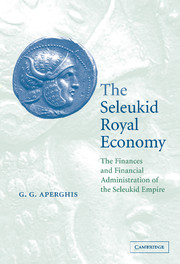Book contents
- Frontmatter
- Contents
- List of figures
- List of tables
- Preface
- List of abbreviations
- Map. The Hellenistic Near East
- Introduction
- Part I PRELIMINARIES
- Chapter 1 Sources and methods
- Chapter 2 Historical summary
- Chapter 3 The posing of a problem
- Part II THE UNDERLYING ECONOMY
- Part III THE ROYAL ECONOMY
- General conclusions
- Appendix I Coin hoards lists
- Appendix 2 Documents and translations
- References
- Index
Chapter 3 - The posing of a problem
from Part I - PRELIMINARIES
Published online by Cambridge University Press: 22 September 2009
- Frontmatter
- Contents
- List of figures
- List of tables
- Preface
- List of abbreviations
- Map. The Hellenistic Near East
- Introduction
- Part I PRELIMINARIES
- Chapter 1 Sources and methods
- Chapter 2 Historical summary
- Chapter 3 The posing of a problem
- Part II THE UNDERLYING ECONOMY
- Part III THE ROYAL ECONOMY
- General conclusions
- Appendix I Coin hoards lists
- Appendix 2 Documents and translations
- References
- Index
Summary
In 311 bc, Seleukos Nikator returned to Babylon with the aim of carving out a territory for himself, much as the other Successors were doing at this time. As one can deduce from his subsequent actions, his first priority seems to have been to defend himself against Antigonos Monophthalmos and consolidate his position in Babylonia, his second to increase his power by adding the Iranian satrapies to his realm and his third to join the coalition against Antigonos, which yielded him northern Syria in 301 bc (ch. 2).
At this point the resources available to Seleukos were a huge territory, with a large population and productive resources (chs. 4, 5), but essentially forming an economy where, with the exception of Babylonia, commodity-based exchange was the norm and where the Achaemenid king's revenue and expenses had been primarily in kind. Seleukos was now in contact with a Mediterranean world where a political game was being played, which relied on gold and silver in coin for the payment of the armies employed by a contender, as he sought to promote himself against his rivals and safeguard his own gains. Seleukos' problem was that he probably had insufficient silver revenues and reserves with which to play this game.
Alexander's capture and coining of most of the stored bullion of the Achaemenid empire, reputedly valued at 180,000 or more talents-worth of gold and silver (Strabo 15.3.9), may not have materially changed the picture in the Asian territories, except for the Mediterranean fringe.
- Type
- Chapter
- Information
- The Seleukid Royal EconomyThe Finances and Financial Administration of the Seleukid Empire, pp. 29 - 32Publisher: Cambridge University PressPrint publication year: 2004



